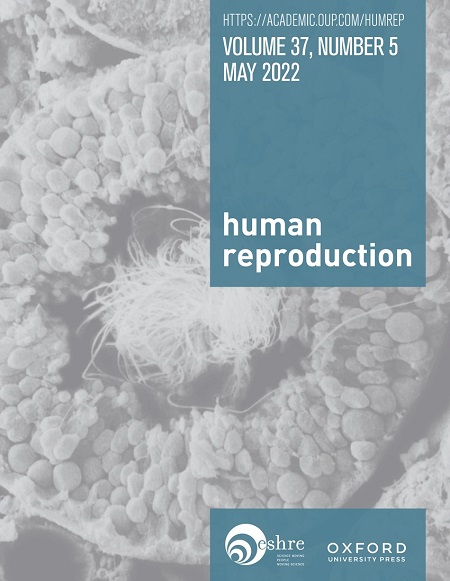Impacts of double biopsy and double vitrification on the clinical outcomes following euploid blastocyst transfer: a systematic review and meta-analysis
IF 6
1区 医学
Q1 OBSTETRICS & GYNECOLOGY
引用次数: 0
Abstract
STUDY QUESTION Compared to the ‘single biopsy + single vitrification’ approach, do ‘double biopsy + double vitrification’ or ‘single biopsy + double vitrification’ arrangements compromise subsequent clinical outcomes following euploidy blastocyst transfer? SUMMARY ANSWER Both ‘double biopsy + double vitrification’ and ‘single biopsy + double vitrification’ led to reduced live birth/ongoing pregnancy rates and clinical pregnancy rates. WHAT IS KNOWN ALREADY? It is not uncommon to receive inconclusive results following blastocyst biopsy and preimplantation genetic testing for aneuploidy (PGT-A). Often these blastocysts are warmed for re-test after a second biopsy, experiencing ‘double biopsy + double vitrification’. Furthermore, to achieve better workflow, IVF laboratories may choose to routinely vitrify all blastocysts and schedule biopsy at a preferred timing, involving ‘single biopsy + double vitrification’. However, in the current literature, there is a lack of systematic evaluation of both arrangements regarding their potential clinical risks in reference to the most common ‘single biopsy + single vitrification’ approach. STUDY DESIGN, SIZE, DURATION A systematic review and meta-analysis were performed, with the protocol registered in PROSPERO (CRD42023469143). A search in PUBMED, EMBASE, and the Cochrane Library for relevant studies was carried out on 30 August 2023, using the keywords ‘biopsy’ and ‘vitrification’ and associated variations respectively. Only studies involving frozen transfers of PGT-A tested euploid blastocysts were included, with those involving PGT-M or PGT-SR excluded. PARTICIPANTS/MATERIALS, SETTING, METHODS Study groups included blastocysts having undergone ‘double biopsy + double vitrification’ or ‘single biopsy + double vitrification’, with a ‘single biopsy + single vitrification’ group used as control. The primary outcome was clinical pregnancy, while secondary outcomes included live birth/ongoing pregnancy, miscarriage, and post-warming survival rates. Random effects meta-analysis was performed with risk ratios (RR) and 95% CIs were used to present outcome comparisons. MAIN RESULTS AND THE ROLE OF CHANCE A total of 607 records were identified through the initial search and nine studies (six full articles and three abstracts) were eventually included. Compared to ‘single biopsy + single vitrification’, ‘double biopsy + double vitrification’ was associated with reduced clinical pregnancy rates (six studies, n = 18 754; RR = 0.80, 95% CI = 0.71–0.89; I2 = 0%) and live birth/ongoing pregnancy rates (seven studies, n = 20 964; RR = 0.72, 95% CI = 0.63–0.82; I2 = 0%). However, no significant changes were seen in miscarriage rates (seven studies, n = 22 332; RR = 1.40, 95% CI = 0.92–2.11; I2 = 53%) and post-warming survival rates (three studies, n = 13 562; RR = 1.00, 95% CI = 0.99–1.01; I2 = 0%) following ‘double biopsy + double vitrification’. Furthermore, ‘single biopsy + double vitrification’ was also linked with decreased clinical pregnancy rates (six studies, n = 13 284; RR = 0.84, 95% CI = 0.76–0.92; I2 = 39%) and live birth/ongoing pregnancy rates (seven studies, n = 16 800; RR = 0.79, 95% CI = 0.69–0.91; I2 = 70%), and increased miscarriage rates (five studies, n = 15 781; RR = 1.48, 95% CI = 1.31–1.67; I2 = 0%), but post-warming survival rates were not affected (three studies, n = 12 452; RR = 0.99, 95% CI = 0.97–1.01; I2 = 71%) by ‘single biopsy + double vitrification’. LIMITATIONS, REASONS FOR CAUTION All studies included in this meta-analysis were retrospective with varying levels of heterogeneity for different outcomes. Not all studies had accounted for potential confounding factors. Only one study reported neonatal outcomes. WIDER IMPLICATIONS OF THE FINDINGS Our data indicated adverse impacts of ‘double biopsy + double vitrification’ and ‘single biopsy + double vitrification’ on clinical outcomes following euploid blastocyst transfers. Patients should be carefully consulted about the risks when offered such approaches. The biopsy process should be carried out as carefully and competently as possible to minimize an inconclusive diagnosis. STUDY FUNDING/COMPETING INTEREST(S) R.W. is supported by a National Health and Medical Research Council Emerging Leadership Investigator Grant (2009767). There is no other external funding to report. All authors report no conflict of interest. REGISTRATION NUMBER CRD42023469143.双活检和双玻璃化对优倍囊胚移植临床结果的影响:系统回顾和荟萃分析
研究问题 与 "单活检+单玻璃化 "方法相比,"双活检+双玻璃化 "或 "单活检+双玻璃化 "安排是否会影响非整倍体囊胚移植后的临床结果?简答 "双活检+双玻璃化 "和 "单活检+双玻璃化 "都会降低活产率/持续妊娠率和临床妊娠率。已经知道了什么?囊胚活检和植入前非整倍体基因检测(PGT-A)结果不确定的情况并不少见。通常情况下,这些囊胚会在第二次活检后进行再次检测,即 "双重活检 + 双重玻璃化"。此外,为了实现更好的工作流程,IVF 实验室可能会选择对所有囊胚进行常规玻璃化处理,并在首选时间安排活检,即 "单次活检 + 双次玻璃化"。然而,与最常见的 "单次活检 + 单次玻璃化 "方法相比,目前的文献缺乏对这两种安排潜在临床风险的系统评估。研究设计、规模、持续时间 进行了系统性综述和荟萃分析,研究方案已在 PROSPERO(CRD42023469143)上注册。2023 年 8 月 30 日,分别使用关键词 "活检 "和 "玻璃化 "及相关变体在 PUBMED、EMBASE 和 Cochrane 图书馆搜索相关研究。只有涉及冷冻移植 PGT-A 检测过的单倍体囊胚的研究才被纳入,涉及 PGT-M 或 PGT-SR 的研究不包括在内。研究组包括经过 "双活检+双玻璃化 "或 "单活检+双玻璃化 "的囊胚,"单活检+单玻璃化 "组作为对照。主要结果是临床妊娠,次要结果包括活产/继续妊娠、流产和升温后存活率。随机效应荟萃分析采用风险比(RR)和95% CI来进行结果比较。主要结果和偶然性的作用 通过初步搜索共发现了 607 条记录,最终纳入了 9 项研究(6 篇全文和 3 篇摘要)。与 "单活检+单玻璃化 "相比,"双活检+双玻璃化 "与临床妊娠率降低(6 项研究,n = 18 754;RR = 0.80,95% CI = 0.71-0.89;I2 = 0%)和活产/持续妊娠率降低(7 项研究,n = 20 964;RR = 0.72,95% CI = 0.63-0.82;I2 = 0%)有关。然而,在 "双活检+双玻璃化 "后,流产率(7 项研究,n = 22 332;RR = 1.40,95% CI = 0.92-2.11;I2 = 53%)和升温后存活率(3 项研究,n = 13 562;RR = 1.00,95% CI = 0.99-1.01;I2 = 0%)没有明显变化。此外,"单活检+双玻璃化 "还与临床妊娠率下降(6 项研究,n = 13 284;RR = 0.84,95% CI = 0.76-0.92;I2 = 39%)和活产/持续妊娠率下降(7 项研究,n = 16 800;RR = 0.79,95% CI = 0.69-0.91;I2 = 70%)有关。91;I2 = 70%),流产率增加(5 项研究,n = 15 781;RR = 1.48,95% CI = 1.31-1.67;I2 = 0%),但 "单次活检 + 双次玻璃化 "不会影响取暖后存活率(3 项研究,n = 12 452;RR = 0.99,95% CI = 0.97-1.01;I2 = 71%)。局限性、注意事项 本荟萃分析所纳入的所有研究均为回顾性研究,不同结果存在不同程度的异质性。并非所有研究都考虑了潜在的混杂因素。只有一项研究报告了新生儿的结果。研究结果的广泛影响 我们的数据表明,"双活检+双玻璃化 "和 "单活检+双玻璃化 "对极倍体囊胚移植后的临床结果有不利影响。在向患者提供此类方法时,应仔细咨询其风险。活检过程应尽可能谨慎和称职,以减少诊断不明确的情况。研究经费/合作利益 R.W.获得了国家健康与医学研究委员会新兴领导研究者资助(2009767)。没有其他外部资金需要报告。所有作者均未报告利益冲突。注册号:CRD42023469143。
本文章由计算机程序翻译,如有差异,请以英文原文为准。
求助全文
约1分钟内获得全文
求助全文
来源期刊

Human reproduction
医学-妇产科学
CiteScore
10.90
自引率
6.60%
发文量
1369
审稿时长
1 months
期刊介绍:
Human Reproduction features full-length, peer-reviewed papers reporting original research, concise clinical case reports, as well as opinions and debates on topical issues.
Papers published cover the clinical science and medical aspects of reproductive physiology, pathology and endocrinology; including andrology, gonad function, gametogenesis, fertilization, embryo development, implantation, early pregnancy, genetics, genetic diagnosis, oncology, infectious disease, surgery, contraception, infertility treatment, psychology, ethics and social issues.
 求助内容:
求助内容: 应助结果提醒方式:
应助结果提醒方式:


